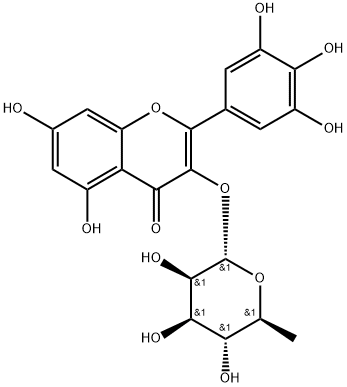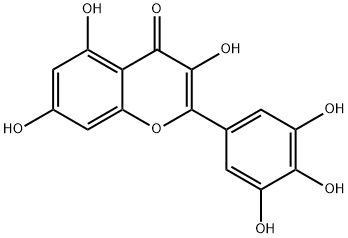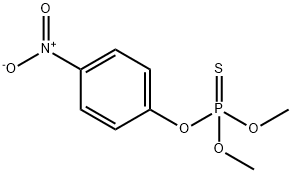Myricitrin
Synonym(s):3,3′,4′,5,5′,7-Hexahydroxyflavone 3-O-rhamnoside;Myricetin 3-O-α-L -rhamnopyranoside;Myricetin 3-O-rhamnoside;Myricitroside
- CAS NO.:17912-87-7
- Empirical Formula: C21H20O12
- Molecular Weight: 464.38
- MDL number: MFCD00016930
- EINECS: 241-856-7
- SAFETY DATA SHEET (SDS)
- Update Date: 2024-11-19 23:02:33

What is Myricitrin?
Chemical properties
White to light yellow powder
The Uses of Myricitrin
It was isolated from the leaves of Myrtus communis; shows antimutagenic activity. Myricitrin was a very potent radical scavenger with an IC50 value of 1.4 .mu.g/mL. Moreover, this compound induced an inhibitory activity against nifuroxazide, aflatoxine B1 and H2O2 induced mutagenicity. Antioxidant.
The Uses of Myricitrin
It was isolated from the leaves of Myrtus communis an inhibitory activity against nifuroxazide, aflatoxine B1 and H2O2 induced mutagenicity. Antioxidant
The Uses of Myricitrin
Myricitrin may be used as an analytical reference standard for determination of the analyte in Folium Rhododendri Micranthi extract using high-performance liquid chromatography. It may also be used as an external standard in the validation of both commercial herbal medicines and crude material of Myrcia uniflora extracts using high-performance liquid chromatography technique.
What are the applications of Application
Myricetin 3-Rhamnoside is a compound which shows antimutagenic activity
Definition
ChEBI: A glycosyloxyflavone that consists of myricetin attached to a alpha-L-rhamnopyranosyl residue at position 3 via a glycosidic linkage. Isolated from Myrica cerifera, it exhibits anti-allergic activity.
General Description
Produced and qualified by HWI pharma services GmbH.
Exact content by quantitative NMR can be found on the certificate.
Biochem/physiol Actions
The metabolite myricitrin, 3-O-rhamnoside of myricetin, is found in plants, e.g. in the bark of Myrica esculenta (Myricaceae) and in the leaves of Myrica gale and in Chrysobalanus icaco. It is a feeding stimulant for some leaf beetles; and shown to have strong antioxidant activity against DPPH. Myricitrin may be of potential interest in the management of inflammatory conditions, and could constitute an attractive molecule of interest for the development of new analgesic drugs. Myricitrin is a nitric oxide (NO) and protein kinase C (PKC) inhibitor that has central nervous system activity, including anxiolytic-like action.
Properties of Myricitrin
| Melting point: | 197°C(lit.) |
| Boiling point: | 896.6±65.0 °C(Predicted) |
| Density | 1.88±0.1 g/cm3(Predicted) |
| FEMA | 4491 | MYRICITRIN |
| storage temp. | -20°C |
| solubility | Soluble to 93 mg/mL
(200.26 mM) in DMSO |
| form | neat |
| pka | 6.16±0.40(Predicted) |
| form | Solid |
| color | Light yellow to Yellow to Orange |
| Odor | bayberry waxy |
| JECFA Number | 2207 |
| CAS DataBase Reference | 17912-87-7(CAS DataBase Reference) |
Safety information for Myricitrin
Computed Descriptors for Myricitrin
New Products
(S)-3-Aminobutanenitrile hydrochloride 4-Methylphenylacetic acid N-Boc-D-alaninol N-BOC-D/L-ALANINOL Tert-butyl bis(2-chloroethyl)carbamate 3-Morpholino-1-(4-nitrophenyl)-5,6-dihydropyridin- 2(1H)-one Furan-2,5-Dicarboxylic Acid Tropic acid 1-Bromo-3,5-Di-Tert-Butylbenzene S-2-CHLORO PROPIONIC ACID ETHYL ISOCYANOACETATE 2-Bromo-1,3-Bis(Dimethylamino)Trimethinium Hexafluorophosphate 4-IODO BENZOIC ACID 3-NITRO-2-METHYL ANILINE 1-(2,4-DICHLOROPHENYL) ETHANAMINE (2-Hydroxyphenyl)acetonitrile 4-Bromopyrazole 2-(Cyanocyclohexyl)acetic acid 4-methoxy-3,5-dinitropyridine 1-(4-(aminomethyl)benzyl)urea hydrochloride 2-aminopropyl benzoate hydrochloride diethyl 2-(2-((tertbutoxycarbonyl)amino) ethyl)malonate tert-butyl 4- (ureidomethyl)benzylcarbamate Ethyl-2-chloro((4-methoxyphenyl)hydrazono)acetateRelated products of tetrahydrofuran








You may like
-
 Myricitrin CAS 17912-87-7View Details
Myricitrin CAS 17912-87-7View Details
17912-87-7 -
 Myricitrin 95.00% CAS 17912-87-7View Details
Myricitrin 95.00% CAS 17912-87-7View Details
17912-87-7 -
 Myricitrin CAS 17912-87-7View Details
Myricitrin CAS 17912-87-7View Details
17912-87-7 -
 Myricitrin CAS 17912-87-7View Details
Myricitrin CAS 17912-87-7View Details
17912-87-7 -
 1975-50-4 98%View Details
1975-50-4 98%View Details
1975-50-4 -
 2-HYDROXY BENZYL ALCOHOL 98%View Details
2-HYDROXY BENZYL ALCOHOL 98%View Details
90-01-7 -
 14714-50-2 (2-Hydroxyphenyl)acetonitrile 98+View Details
14714-50-2 (2-Hydroxyphenyl)acetonitrile 98+View Details
14714-50-2 -
 118753-70-1 98+View Details
118753-70-1 98+View Details
118753-70-1